The Intel SSD 540s (480GB) Review
by Billy Tallis on June 23, 2016 9:00 AM ESTMixed Random Read/Write Performance
The mixed random I/O benchmark starts with a pure read test and gradually increases the proportion of writes, finishing with pure writes. The queue depth is 3 for the entire test and each subtest lasts for 3 minutes, for a total test duration of 18 minutes. As with the pure random write test, this test is restricted to a 16GB span of the drive, which is empty save for the 16GB test file.
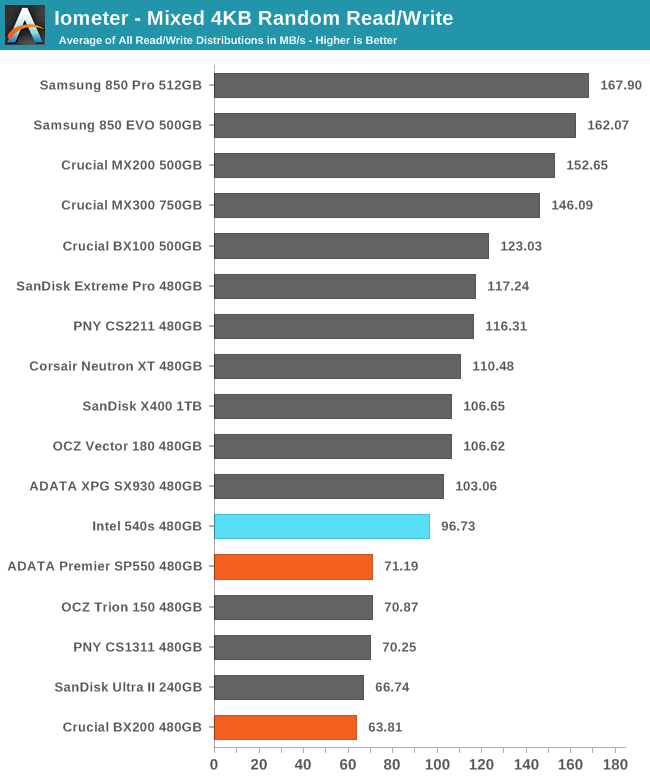
On the mixed random I/O test the Intel 540s has a stark advantage over almost all other planar TLC drives, and is close to the low-end MLC drives and SanDisk X400.
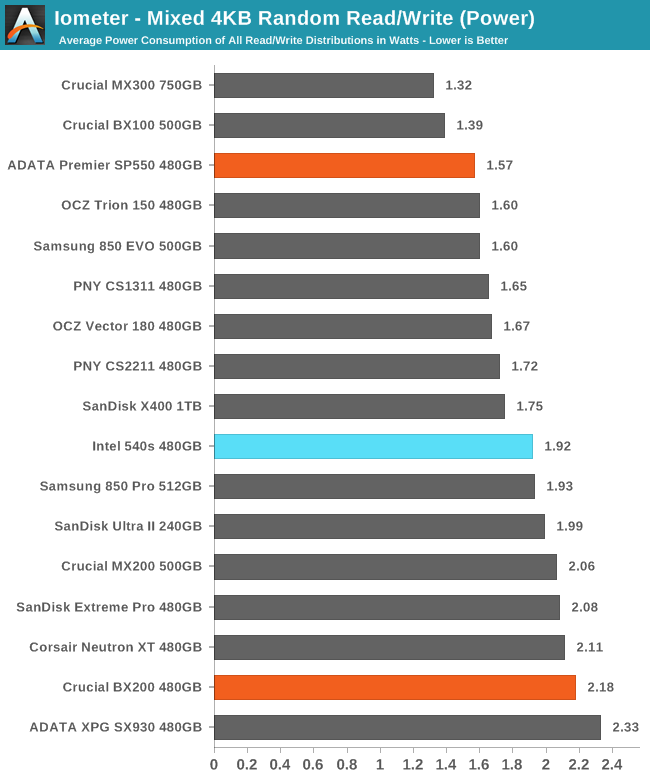
Power consumption is middle of the road, so the Intel 540s comes out at ahead of most of the TLC drives in terms of efficiency, though the SP550 is not far behind.
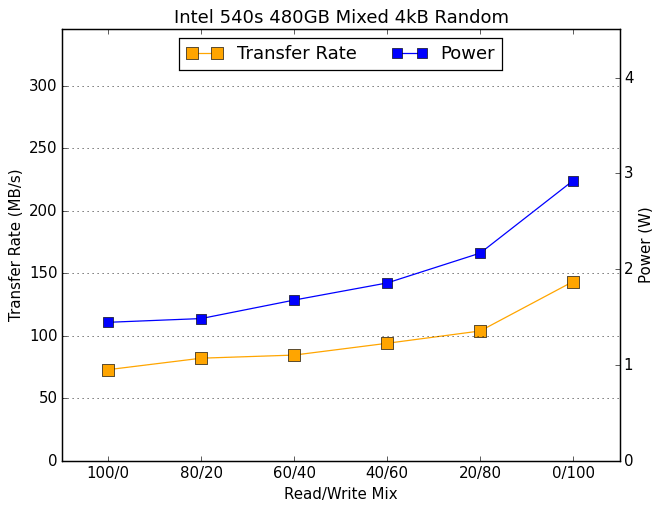 |
|||||||||
The performance of the Intel 540s never dropped as the proportion of writes in the workload increased, but it also didn't show the common big jump in performance during the final pure-write phase of the test.
Mixed Sequential Read/Write Performance
The mixed sequential access test covers the entire span of the drive and uses a queue depth of one. It starts with a pure read test and gradually increases the proportion of writes, finishing with pure writes. Each subtest lasts for 3 minutes, for a total test duration of 18 minutes. The drive is filled before the test starts.
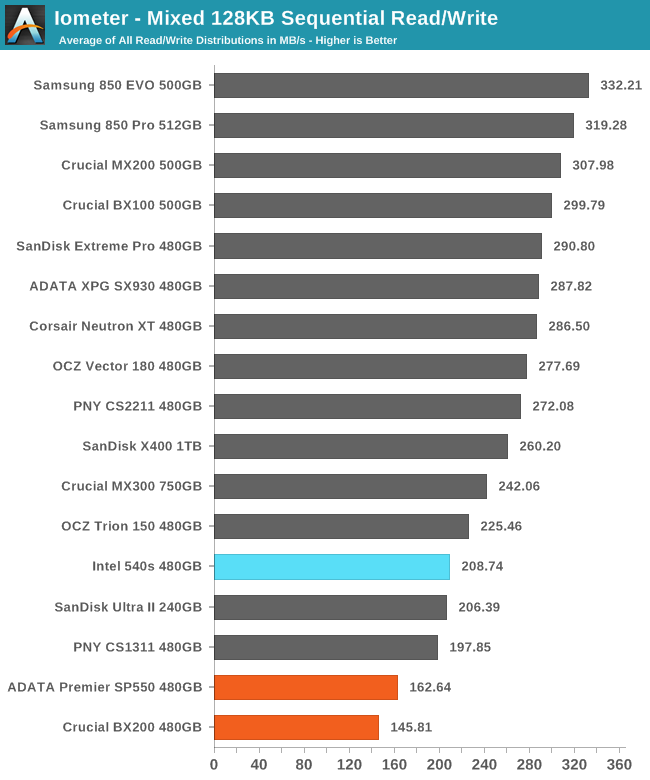
The mixed sequential I/O performance of the Intel 540s is significantly improved over the SM2256 drives, but that still only brings it up to par for planar TLC.
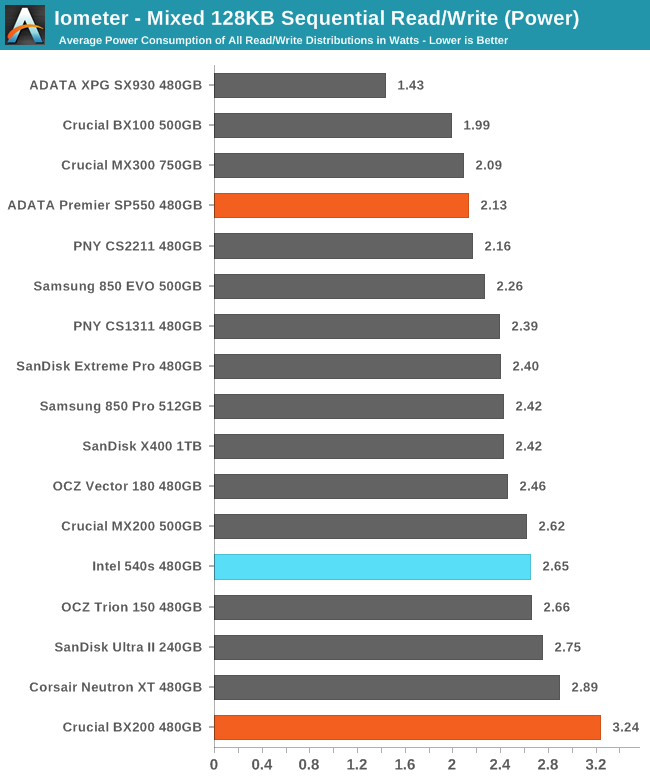
The power usage of the Intel 540s is relatively high, so it doesn't have great efficiency even by TLC standards.
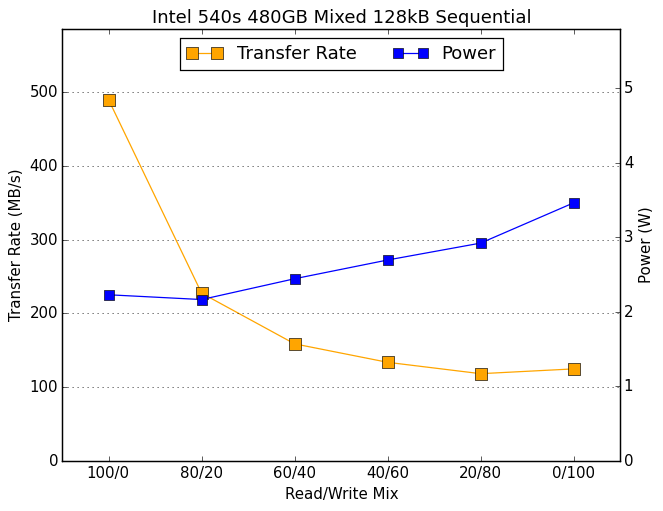 |
|||||||||
The Intel 540s is both faster and more power hungry than the SP550 at every point during this test. Performance still doesn't bounce back appreciably with the pure writes phase of the test, which keeps the average down despite the good read performance at the beginning.










77 Comments
View All Comments
Flunk - Thursday, June 23, 2016 - link
Looks like it's on Intel's low-end product map for well into 2017 (which is as far as that goes).BurntMyBacon - Friday, June 24, 2016 - link
I thought that Intel's low-end was the 300 series. Apparently not anymore:https://benchlife.info/mansion-brighton-stony-beac...
Please post another link to a roadmap if you find one not plastered with a website logo.
JKJK - Thursday, June 23, 2016 - link
520 and 530 stuck with us for forever, even still when they where performance wise surpassed by other manufacturers. And the price didn't budge either, so I suppose 540 will be with us for a while.However, I'm pretty disappointed with Intel on this one. Samsung 750 evo and even 850 evo is way cheaper here in Norway.
Impulses - Thursday, June 23, 2016 - link
They're at price parity in the US right now, 'course the EVO is much better for the money...Flunk - Thursday, June 23, 2016 - link
That's a lot of money to pay for a low-end drive with a Silicon Motion controller. Performance like a Trion, price like an 850 Evo. Good work Intel.BrokenCrayons - Thursday, June 23, 2016 - link
In their defense, it's not a terrible performer relative to other planar TLC drives with the same controller. However, that doesn't excuse the much higher price MSRP. Were I in the market for a new drive, I wouldn't write off TLC, but I would write off the 540 right away based on the cost over its nearest competitors.Guspaz - Thursday, June 23, 2016 - link
So, it's an Intel SSD that doesn't use an Intel controller, doesn't use Intel flash, and provides terrible performance at a much higher prices than the competition.What were they thinking? I've always been a bit of an Intel SSD fanboy (the five standalone SSDs that I've bought over the years have all been Intel, all the way back to the G1), but they've clearly lost their way, and I don't think the next SSD that I buy would be an Intel.
hojnikb - Thursday, June 23, 2016 - link
They probably want to bank on the clueless users, that have little idea of SSD performance but know Intel as a brand.BurntMyBacon - Friday, June 24, 2016 - link
@Guspaz: "So, it's an Intel SSD that doesn't use an Intel controller, doesn't use Intel flash, and provides terrible performance at a much higher prices than the competition."They did use Sandforce controllers for a while. Though their performance was pretty decent at the time. Firmware made the difference in reliability. Since they are still doing their own firmware and validation, I don't think the use of a third party controller or flash is an insurmountable problem. I do think that the product is not priced or named correctly. This should be a 300 series part with a 300 series price.
Note: The relatively high price may be correlated with the fact that they have to acquire flash on the open market and not everything they get is necessarily meeting their validation requirements.
pwil - Wednesday, July 27, 2016 - link
3 in 3xx series means 3y warranty.